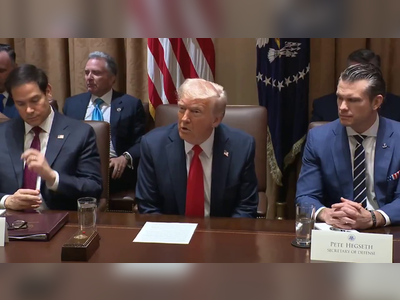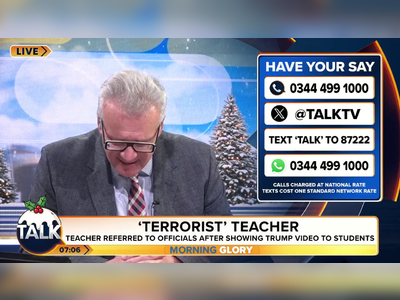
Beware False Endings
At a time when uncertainty may be the election’s only immediate result, Americans have an opportunity to rethink the way stories are told.
Earlier this week, a striking thing happened at the Supreme Court: A justice inserted several errors into the record. The mistakes came as the Court was making last-minute decisions about the precise time span of an election that has been taking place for weeks. The errors were products, as The New York Times put it, of “the court’s fast pace in handling recent challenges to voting rules.”
They also emphasized the extent to which the election is being waged through proxy campaigns-through battles that treat voting not just as the voice of the public, but also as a matter of logistics. How will votes be processed? How will they be, right out in the open, suppressed? When will they stop being counted?
And when will this election, technically, end?
News organizations will help answer that last question. That is in part because, as the New York Times columnist Ben Smith wrote in August, “the American media plays a bizarrely outsize role in American elections, occupying the place of most countries’ national election commissions.” As local election boards process ballots and report the results, news outlets-TV news outlets, in particular-will make projections.
They will make announcements. And they will be contending with a mess of complications that include, this year, an incumbent president who has made no secret of his desire to sow chaos and confusion. The responsibility held by media organizations, in this context, will be immense: They will need to not only inform their viewers, but also orient them. And explain vote-tabulation processes to people who may not be familiar with them. And debunk-or strategically ignore-any misinformation that is churned out into the mix.
They will also, crucially, need to do something that tends not to come naturally, to human beings in general and to the humans of the press: They will need to accept uncertainty. “When every legitimate vote is tallied and we get to that final day, which will be some day after Election Day, it will in fact show that what happened on election night was … a mirage,” the CEO of a top Democratic data-and-analytics firm told Axios earlier this fall. This is the situation, he argued, that might become clear in retrospect: “It looked like Donald Trump was in the lead and he fundamentally was not when every ballot gets counted.”
A scenario like this would pose a challenge to a medium that thrives on discrete dramas and tidy stories. News programs are organized into segments-episodes that have beginnings and middles and ends. But very little about Election Night will lend itself to such organization. It is very possible, for one thing, that Election Night will not be a single night at all.
In that environment, CNN and Fox and MSNBC and the broadcast networks will need to work against instinct. They will need to model patience and calm. They will need to fight the desire to tell stories that have concrete endings.
The Trump administration, for its part, constantly engages in battles for unearned endings. On Wednesday, the White House Office of Science and Technology sent out a press release highlighting the scientific accomplishments it claimed to have achieved over the past four years. One of the items on the list? “ENDING THE COVID-19 PANDEMIC.” (On Thursday, the United States reported more new cases of the disease than on any other day since the pandemic began.)
The release came soon after the White House, hoping to solidify a conservative majority on the Supreme Court should the election results end up being decided there, rushed the confirmation process of Amy Coney Barrett. (One of Barrett’s new colleagues on the bench, Brett Kavanaugh, benefited from a 2018 confirmation process that was similarly beset by manufactured haste: “We’re going to plow right through it,” Mitch McConnell said of the vote at the time-and that is just what the Senate did.)
News organizations have occasionally abetted the White House in its quests to declare presumptive victory. Earlier this year, NBC News published an analysis complaining that the impeachment hearings of the president of the United States were lacking in “pizzazz.” Reuters agreed: “Unlike the best reality TV shows-not to mention the Trump presidency itself-fireworks and explosive moments were scarce,” the news service noted with a nearly audible sigh.
The assessments were assuming that the most important thing for an impeachment trial to be was not rigorous or careful, but instead exciting. They were arguing, effectively, that a civic event playing out on television should operate as a TV show. They wanted plot twists and cliff-hangers and moments of tidy drama. When none came, they dismissed the whole exercise as evidence of bad TV.
Donald Trump is himself a creature of television. His image was magnified by TV; his reputation was laundered by it. And he has brought the underlying logic of television-in particular, its assumption that every day is a new episode that might erase what came before-to his governance of the country.
He has treated the White House’s coronavirus press conferences, when he holds them, as blank-slate opportunities to recast the day’s reality in his preferred terms. He treated his own infection with COVID-19 as a nearly sitcomic event: drama and resolution in one easy episode, the ending punctuated by a declaration from the president that he had been “healed.”
In May, Politico published a story outlining the Trump administration’s decision to reopen the American economy despite the ongoing presence of the coronavirus. The administration took that action against the advice of the White House’s own health advisers. “There’s this mindset that it’s like running a show and you’ve got to keep people tuned in, you’ve got to keep them interested and at some point you’ve got to move on and move on quickly,” a former Health and Human Services official told Politico. “Viewers will get tired of another season of coronavirus.”
This is impatience rendered as public policy; it assumes that the American attention span is as limited as the president’s. It has its insights: Americans are, indeed, exhausted. This show has gone on for far too long. But Americans have also been living through a cultural moment of delayed, or fractured, endings. Cliff-hangers keep hanging.
Podcasts tell their tales over weeks and months, punctuating statements not with periods so much as ellipses; they bring the shapelessness of the internet-Facebook feeds and Twitter streams-to their storytelling. It’s no surprise that this is also the age of the reboot and the sequel, in which characters come back from the dead so regularly that every person in fiction-or, more cynically, every piece of intellectual property-has the potential to be Lazarus-ed.
Saved by the Bell has been saved for a new generation. Supermarket Sweep is sweeping once more. Insider, earlier this month, offered a list of “TV reboots, remakes, and spin-offs that are in the works.” The list has 25 entries.
That environment of constant churn-the ongoing sense of no ending-could prove beneficial should Election Night become Election Week, or even Election Month. Americans have already begun making their peace with uncertainty. For better or worse, we are slowly learning patience. “There Won’t Be a Clear End to the Pandemic,” my colleague Joe Pinsker wrote in September. (Instead, he noted, Americans should expect “a slow fade into a new normal.”)
The pandemic, that framing acknowledges, isn’t a single story-any more than climate change or racial justice or economic inequality are single stories. This has been a year of partial acclimation to that fact. Endings are seductive. They suggest order, and resolution, and relief. But they don’t always suggest the world as it is. That realization might help Americans to prepare for the times ahead.
They also emphasized the extent to which the election is being waged through proxy campaigns-through battles that treat voting not just as the voice of the public, but also as a matter of logistics. How will votes be processed? How will they be, right out in the open, suppressed? When will they stop being counted?
And when will this election, technically, end?
News organizations will help answer that last question. That is in part because, as the New York Times columnist Ben Smith wrote in August, “the American media plays a bizarrely outsize role in American elections, occupying the place of most countries’ national election commissions.” As local election boards process ballots and report the results, news outlets-TV news outlets, in particular-will make projections.
They will make announcements. And they will be contending with a mess of complications that include, this year, an incumbent president who has made no secret of his desire to sow chaos and confusion. The responsibility held by media organizations, in this context, will be immense: They will need to not only inform their viewers, but also orient them. And explain vote-tabulation processes to people who may not be familiar with them. And debunk-or strategically ignore-any misinformation that is churned out into the mix.
They will also, crucially, need to do something that tends not to come naturally, to human beings in general and to the humans of the press: They will need to accept uncertainty. “When every legitimate vote is tallied and we get to that final day, which will be some day after Election Day, it will in fact show that what happened on election night was … a mirage,” the CEO of a top Democratic data-and-analytics firm told Axios earlier this fall. This is the situation, he argued, that might become clear in retrospect: “It looked like Donald Trump was in the lead and he fundamentally was not when every ballot gets counted.”
A scenario like this would pose a challenge to a medium that thrives on discrete dramas and tidy stories. News programs are organized into segments-episodes that have beginnings and middles and ends. But very little about Election Night will lend itself to such organization. It is very possible, for one thing, that Election Night will not be a single night at all.
In that environment, CNN and Fox and MSNBC and the broadcast networks will need to work against instinct. They will need to model patience and calm. They will need to fight the desire to tell stories that have concrete endings.
The Trump administration, for its part, constantly engages in battles for unearned endings. On Wednesday, the White House Office of Science and Technology sent out a press release highlighting the scientific accomplishments it claimed to have achieved over the past four years. One of the items on the list? “ENDING THE COVID-19 PANDEMIC.” (On Thursday, the United States reported more new cases of the disease than on any other day since the pandemic began.)
The release came soon after the White House, hoping to solidify a conservative majority on the Supreme Court should the election results end up being decided there, rushed the confirmation process of Amy Coney Barrett. (One of Barrett’s new colleagues on the bench, Brett Kavanaugh, benefited from a 2018 confirmation process that was similarly beset by manufactured haste: “We’re going to plow right through it,” Mitch McConnell said of the vote at the time-and that is just what the Senate did.)
News organizations have occasionally abetted the White House in its quests to declare presumptive victory. Earlier this year, NBC News published an analysis complaining that the impeachment hearings of the president of the United States were lacking in “pizzazz.” Reuters agreed: “Unlike the best reality TV shows-not to mention the Trump presidency itself-fireworks and explosive moments were scarce,” the news service noted with a nearly audible sigh.
The assessments were assuming that the most important thing for an impeachment trial to be was not rigorous or careful, but instead exciting. They were arguing, effectively, that a civic event playing out on television should operate as a TV show. They wanted plot twists and cliff-hangers and moments of tidy drama. When none came, they dismissed the whole exercise as evidence of bad TV.
Donald Trump is himself a creature of television. His image was magnified by TV; his reputation was laundered by it. And he has brought the underlying logic of television-in particular, its assumption that every day is a new episode that might erase what came before-to his governance of the country.
He has treated the White House’s coronavirus press conferences, when he holds them, as blank-slate opportunities to recast the day’s reality in his preferred terms. He treated his own infection with COVID-19 as a nearly sitcomic event: drama and resolution in one easy episode, the ending punctuated by a declaration from the president that he had been “healed.”
In May, Politico published a story outlining the Trump administration’s decision to reopen the American economy despite the ongoing presence of the coronavirus. The administration took that action against the advice of the White House’s own health advisers. “There’s this mindset that it’s like running a show and you’ve got to keep people tuned in, you’ve got to keep them interested and at some point you’ve got to move on and move on quickly,” a former Health and Human Services official told Politico. “Viewers will get tired of another season of coronavirus.”
This is impatience rendered as public policy; it assumes that the American attention span is as limited as the president’s. It has its insights: Americans are, indeed, exhausted. This show has gone on for far too long. But Americans have also been living through a cultural moment of delayed, or fractured, endings. Cliff-hangers keep hanging.
Podcasts tell their tales over weeks and months, punctuating statements not with periods so much as ellipses; they bring the shapelessness of the internet-Facebook feeds and Twitter streams-to their storytelling. It’s no surprise that this is also the age of the reboot and the sequel, in which characters come back from the dead so regularly that every person in fiction-or, more cynically, every piece of intellectual property-has the potential to be Lazarus-ed.
Saved by the Bell has been saved for a new generation. Supermarket Sweep is sweeping once more. Insider, earlier this month, offered a list of “TV reboots, remakes, and spin-offs that are in the works.” The list has 25 entries.
That environment of constant churn-the ongoing sense of no ending-could prove beneficial should Election Night become Election Week, or even Election Month. Americans have already begun making their peace with uncertainty. For better or worse, we are slowly learning patience. “There Won’t Be a Clear End to the Pandemic,” my colleague Joe Pinsker wrote in September. (Instead, he noted, Americans should expect “a slow fade into a new normal.”)
The pandemic, that framing acknowledges, isn’t a single story-any more than climate change or racial justice or economic inequality are single stories. This has been a year of partial acclimation to that fact. Endings are seductive. They suggest order, and resolution, and relief. But they don’t always suggest the world as it is. That realization might help Americans to prepare for the times ahead.










